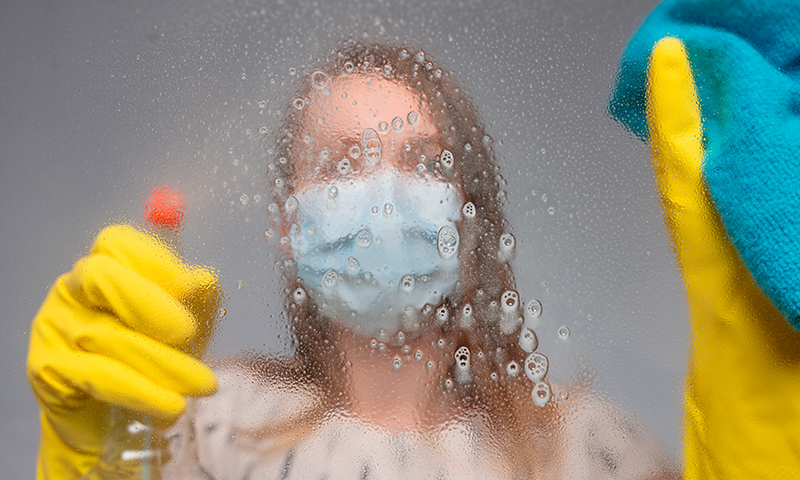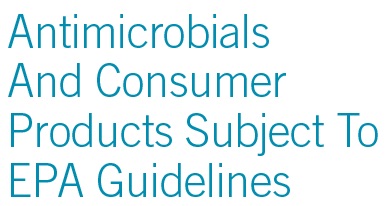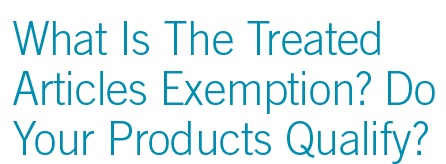Product Responsibility: The Real Facts On Antimicrobial Products

Antimicrobial products are intended to disinfect, sanitize, reduce or mitigate the spread or development of microbiological organisms, including bacteria, viruses, protozoans and fungi, such as mold and mildew.
While the U.S. Food and Drug Administration (FDA) regulates antimicrobial products as drugs or antiseptics intended for use on or in the body, the U.S. Environmental Protection Agency (EPA) regulates antimicrobial products as pesticides for use on inanimate objects or surfaces such as kitchen counters, toys or grocery carts.
This article focuses on those products regulated by the EPA under the Federal Insecticide, Fungicide, and Rodenticide Act (FIFRA) detailing the applicable regulations and labeling requirements, the exceptions and the potential challenges for companies navigating compliance and the demand for safe products during the current pandemic.

FIFRA: Originally passed into law in 1947, FIFRA was enacted as a “truth in labeling” law. It standardized the information required to submit a new pesticide for market approval in the United States, testing standards and established standards for labeling. FIFRA has subsequently been amended to require registration of all pesticides, including antimicrobial pesticides.
Antimicrobials: All antimicrobial pesticides require registration with the EPA and in every state in which they are distributed. These products are evaluated based on their chemistry, toxicology, product efficacy, and the manufacturer’s proscribed environment for usage based on guidelines established under FIFRA.
Products labeled, packaged or marketed with claims to kill, control, repel, mitigate, destroy or reduce a pest, germ or microbe are considered to be or to contain a pesticide subject to EPA regulations and registration requirements.
The EPA distinguishes between those antimicrobial pesticides intended to address needs in a public health setting and those that do not. Both categories require products to be labeled with application instructions for effective usage and first aid instructions in case of accidental exposure.
- Public health antimicrobials are intended to control germs infectious to humans in an inanimate environment. These products include sterilizers, disinfectants and sanitizers. Hospitals, schools, other institutions, industrial settings such as food processing facilities and homes rely on these products in their cleaning regimens to contain the spread of a range of infectious microorganisms, including COVID-19.
- Non-public health antimicrobials are intended to inhibit growth of microbes that cause aesthetic or economic harm. Examples include algae, odor-causing bacteria, and microbes that result in spoilage of materials including, but not limited to, textiles, paints and jet fuel.
Products that control a pest, germ or microbe through a physical or mechanical action can also be labeled as antimicrobial. These products, considered to be devices, are not subject to EPA regulation. (Examples of promotional products that kill microbes include a UV case for sanitizing cellphones or an air purifier.)
Some products treated with an antimicrobial are expressly exempt from FIFRA’s registration requirements. Many promotional products for which antimicrobial claims are made fall within this last category.
Examples of Treated Product Antimicrobial Claims
For mold- or mildew-resistant claims:
- This article has been treated with a fungistatic agent to protect the product from fungal growth.
- Mildew-resistant: extends useful life of article by controlling deterioration caused by mildew.
- The fungistatic agent in this article makes it especially useful for resisting deterioration caused by mildew.
- Article treated to resist deterioration by mold fungus.
- Provides mildew-resistant coating.
For odor-resistant claims:
- This product contains an antimicrobial agent to control odors.
- This product contains an antimicrobial agent to prevent microorganisms from degrading the product.
- Resists odors: this product has been treated to resist bacterial odors.
- Inhibits the growth of bacterial odors.
- Resists microbial odor development.
- Retards the growth of odors from microbial causes.
- Guards against degradation from microorganisms.
- Reduces odors from microorganisms.
- Odor-resistant.
- Acts to mitigate the development of odors.

The EPA defines “treated articles” as: An article or substance treated with or containing a(n) (antimicrobial) pesticide to protect the article or substance itself (for example, paint treated with a pesticide to protect the paint coating or wood products treated to protect the wood against insects or fungus infestation), if the pesticide is registered for such use.
To qualify for the “treated articles exemption,” both conditions—a) that the sole purpose of the treatment is to protect the article and b) that the incorporated pesticide is registered for the specific use in or on the article—must be satisfied. Failure to meet either condition disqualifies the article or substance from the treated articles exemption. The disqualified product is then subject to regulation under FIFRA and requires registration as a pesticide.
Antimicrobial pesticides are applied to treated articles during their manufacture. The treatment (or application) process may include adding the pesticide to the materials or ingredients used to produce the item or in the surface coating applied to that item.
The EPA grants treated articles exemptions for non-public health usages only. For practical purposes only antimicrobial treatments impacting the aesthetic properties or those properties related to mitigating spoilage of materials qualify for this exemption.
Products that qualify for exemption must be marketed with a qualifying statement specific to the nature of the protection offered by the antimicrobial treatment. Approved claims for antimicrobial properties qualifying for the exemption have included mold and mildew resistance, odor resistance and material preservatives. Some claims that have been approved by the EPA are listed above in "Examples of Treated Product Antimicrobial Claims."
The exemption also requires qualifying statements addressing the protection provided by the application of the antimicrobial to the item to accompany the product or substance and to appear together with the claim. The following is an example of a qualifying statement:
This product contains a preservative built in or applied in the coating to protect the product. Antimicrobial properties are built in to inhibit the growth of bacteria that may affect this product. The antimicrobial properties do not protect users or others against bacteria, viruses, germs or other disease organisms. Always clean and wash this product thoroughly before and after each use.
Per FIFRA guidance, the claim—in this case, a preservative claim—and qualifying statement on the product packaging and in marketing materials must be given no greater prominence with regard to font, size or color than any other product features described.
Making an implied or explicit public health claim such as “antibacterial,” “effective against the coronavirus COVID-19” or “improves air quality” disqualifies the product from exemption and requires the manufacturer to register the product as an antimicrobial pesticide. Likewise, using “antimicrobial” or “antibacterial” in the name of a product would disqualify the product from the exemption.

If you have checked all the boxes in qualifying your product for the treated product exemption, 40 CFR 152.25(a) requires manufacturers to be able to demonstrate that the antimicrobial pesticide in the treated article or substance is present solely as the result of incorporating an antimicrobial pesticide which is registered for treating the specific article or substance.
Having an up-to-date bill of materials that clearly identifies all surface coatings and additives allows a manufacturer to quickly identify antimicrobials added to the product or the surface coating. Independent, third-party laboratory testing for claimed properties provides validation of those claims.
The registration and labeling of an antimicrobial pesticide intended for incorporation into a treated article or substance must include specific listings of articles or substances that may be treated.
The EPA has rejected broad general-use claims, such as “the preservation of hard surfaces, plastics, adhesives or coatings” for registering antimicrobial pesticides. Instead, the agency requires distinct listings such as “toys,” “kitchen accessories” and “clothing articles” to be reflected in the antimicrobial product’s registration, labeling and marketing collateral as a prerequisite for incorporation of the antimicrobial into an article or substance exempted from FIFRA registration under 40 CFR 152.25(a).
Manufacturers are encouraged to request an updated antimicrobial product registration from your vendors.

The way product claims are phrased may determine your company’s compliance with FIFRA and other regulatory requirements. If an inanimate product is depicted in any way as possessing antimicrobial pesticide qualities, enforcement actions may be taken by the EPA.
Companies, though, have claimed "antibacterial" and "antimicrobial" qualities are extended to users of their products in commercial settings for a range of products including socks, shoes, shower curtains, sponges, face masks, hospital gowns, cutting boards, toys and so forth.
The Federal Trade Commission (FTC) regulates false and deceptive claims. The agency’s powers are limited in that it must demonstrate a “substantial interest” in limiting specific claims, that the restrictions imposed directly advance the asserted interest and that restrictions are reasonable.
With a proliferation of antimicrobial-treated products in the late 1990s, the FTC, in collaboration with the EPA, determined manufacturers must establish the degree and duration of a protection when making a claim related to antimicrobials. All labels, advertising and marketing claims must be accurate and scientifically substantiated.
In a July 17, 1998 letter from the FTC’s Division of Advertising Practices on the “treated articles” exemption, the FTC stated: “The Commission staff notes, as has EPA, the recent proliferation of consumer products containing ‘antibacterial’ or ‘antimicrobial’ agents, accompanied by advertising and labeling claims about the efficacy of those agents in providing protection against bacteria or germs. We support EPA's judgment that, in many instances, claims concerning the antimicrobial or antibacterial properties of such products imply a public health benefit, i.e., that the control or elimination of germs and bacteria helps protect users against disease, rather than simply preserving the product itself against rot, deterioration, mold, or mildew. This implication is likely to be particularly strong for products and in circumstances where consumers are not concerned about microbial damage to the product itself, but instead have generalized concerns about the spread of disease-causing germs.”
When the consumer is likely to be swayed by product claims with the implications of efficacy for human health or the qualifying statement appears to contradict the claim and confuse consumers, the FTC is likely to issue a warning to the manufacturer. If a complaint is issued and found to have merit, further violations can result in a civil penalty of $16,000 for each occurrence.
![]()
Before you consider that face mask treated with a registered antimicrobial to prevent the growth of odor-causing bacteria on the mask and claiming the face mask has antimicrobial properties that may be effective in preventing the spread of coronavirus, consider the science available about the antimicrobial. What does the antimicrobial do? How long does it last? Is the claim likely to be misunderstood by a consumer focused on keeping their family, friends and community safe in the current environment?
Knowing your products in order to make accurate claims is the surest way for ensuring safe products.
Links To Additional Resources
- Registering antimicrobial pesticides: www.epa.gov/pesticide-registration/
antimicrobial-pesticide-registration - The FTC’s role: www.ftc.gov/about-ftc/what-we-do/enforcement-authority
- Antimicrobial factsheet:
npic.orst.edu/factsheets/antimicrobials.html#:~:text=You%20may%20find%20antimicrobial%20products,antimicrobial%20products%20as%20drugs%2Fantiseptics - EPA pesticide registration: www.epa.gov/pesticide-registration/prn-2000-1-applicability-treated-articles-exemption-antimicrobial-pesticides
- Treated article exemption: www.epa.gov/safepestcontrol/consumer-products-treated-pesticides
–––––––––––––––––––––––––––––––––––––––––––––––––––––––––––
D.E. Fenton was most recently executive director at Quality Certification Alliance. After 12 years, the organization concluded its mission and wrapped up operations on August 1.

